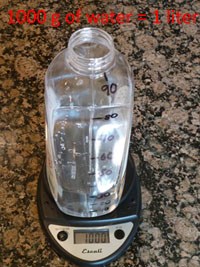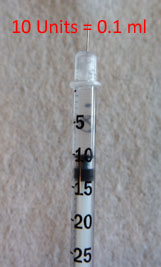Hi, I just joined TFP this season and pool is looking great. TFP is an awesome resource. Thanks
I thought the information below might be helpful for some of the forum participants.
I recently bought 1 jug of 10% Liquid Chlorine that was actually 4.5%. It had a 2013 date code. I now am very careful to check the date code before I purchase.
I thought this might be a handy reference for checking bleach/liquid chlorine date codes. This decoder is for the brands that are available in my area. If you have other brands please add to this thread if you want.
Note: Further down I show an easy way to measure the strength of your bleach/liquid chlorine.
Bleach/Liquid Chlorine starts decomposing after it is manufactured. Check this link (scroll down) to see the half-life table (half-life means half of the original strength). Note that decomposition occurs faster for higher strength chlorine and faster at higher storage temperatures.
Bleach/Liquid Chlorine Date Code Decoder (Year/Day of Year)
Here is a Julian Date chart.
Clorox
A5 3 183 TX-1 08:41 (Day 183 of 2013)
Walmart Great Value
14 183 11:03 B1
Walmart White Cloud
14 144 12L59 B2 TX-01
Smart (Home Depot)
34713FL07:30
HTH Liquid Chlorinator
14JA0366B 11:15
Kem-Tek
1416210:25C
Dollar General
14 169 02:59 B2 TX-01
Online Packaging Inc
BB 07/01/15 (Date of Manufacture is 1 year prior to the "Best By:" date.) In this case Manufactured date is 07/01/2014.
Easy way to measure strength of bleach/liquid chlorine.
A 10,000 to 1 dilution of chlorine will result in chlorine ppm equal to its strength (percent). All you need to do is to make the 10,000 to 1 dilution, then measure the ppm using a FAS-DPD test kit. Example: If the dilution measures 8.5ppm, then your bleach strength is 8.5%.
Step 1: Measure 1 liter of Deionized or Distilled water. Here I’m measuring 1000 grams (1 liter) of water using a kitchen scale.

Step 2: Measure 0.1 ml of the bleach/liquid chlorine. This is easy to do by using a 0.3 ml u-100 insulin syringe and filling it to the 10 units mark (10 units of u-100 insulin is 0.1 ml)


Step 3: Add the 0.1 ml of bleach to the 1 liter of water and mix.
Step 4: Using a FAS-DPD test kit, measure the FC ppm (CC should be zero) of the dilution. The measured ppm is the percent strength of your bleach/liquid chlorine.
Hope this is helpful to some.
I thought the information below might be helpful for some of the forum participants.
I recently bought 1 jug of 10% Liquid Chlorine that was actually 4.5%. It had a 2013 date code. I now am very careful to check the date code before I purchase.
I thought this might be a handy reference for checking bleach/liquid chlorine date codes. This decoder is for the brands that are available in my area. If you have other brands please add to this thread if you want.
Note: Further down I show an easy way to measure the strength of your bleach/liquid chlorine.
Bleach/Liquid Chlorine starts decomposing after it is manufactured. Check this link (scroll down) to see the half-life table (half-life means half of the original strength). Note that decomposition occurs faster for higher strength chlorine and faster at higher storage temperatures.
Bleach/Liquid Chlorine Date Code Decoder (Year/Day of Year)
Here is a Julian Date chart.
Clorox
A5 3 183 TX-1 08:41 (Day 183 of 2013)
Walmart Great Value
14 183 11:03 B1
Walmart White Cloud
14 144 12L59 B2 TX-01
Smart (Home Depot)
34713FL07:30
HTH Liquid Chlorinator
14JA0366B 11:15
Kem-Tek
1416210:25C
Dollar General
14 169 02:59 B2 TX-01
Online Packaging Inc
BB 07/01/15 (Date of Manufacture is 1 year prior to the "Best By:" date.) In this case Manufactured date is 07/01/2014.
Easy way to measure strength of bleach/liquid chlorine.
A 10,000 to 1 dilution of chlorine will result in chlorine ppm equal to its strength (percent). All you need to do is to make the 10,000 to 1 dilution, then measure the ppm using a FAS-DPD test kit. Example: If the dilution measures 8.5ppm, then your bleach strength is 8.5%.
Step 1: Measure 1 liter of Deionized or Distilled water. Here I’m measuring 1000 grams (1 liter) of water using a kitchen scale.

Step 2: Measure 0.1 ml of the bleach/liquid chlorine. This is easy to do by using a 0.3 ml u-100 insulin syringe and filling it to the 10 units mark (10 units of u-100 insulin is 0.1 ml)


Step 3: Add the 0.1 ml of bleach to the 1 liter of water and mix.
Step 4: Using a FAS-DPD test kit, measure the FC ppm (CC should be zero) of the dilution. The measured ppm is the percent strength of your bleach/liquid chlorine.
Hope this is helpful to some.
Last edited:

